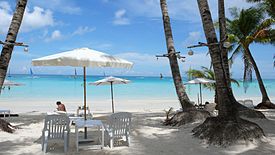Sites to visit in Philippines "Boracay"
Any iconic photos of Boracay you’ve seen are likely to be from the westward-facing White Beach — four kilometers of white, powdery fine sand dotted with resorts, shops, and restaurants.

White Beach is composed of three sections.
The northernmost section – Station 1 – has the widest beachfront. This has the best (and most expensive) resorts and hotels.
The center of White Beach is Station 2. People come here to eat, shop, and party.

If you’re looking for a quieter area, then Station 3, the southernmost section, is for you.
Because the waters off White Beach are calm during Amihan season (November to May), tourism is at its peak during these months when the northeastern winds blow. Conditions reverse during the rainy season, when the Habagat or monsoon winds blow.
Bulabog Beach, on the eastern side of the island opposite White Beach, has large waves and strong winds year-round. This makes it a hotspot for windsurfing and kiteboarding. In fact, Bulabog Beach is considered Asia’s top kitesurf destination.
Whichever side of the island or end of the beach you choose, there’s a room for every type of traveler here. Budget accommodations start at around US$ 17, and can go all the way to US$ 300 per person at prime resorts like Discovery Shores.

And because Boracay gets tourists from different parts of the globe, you’ll find a wide variety of food choices: Chinese, Indian, American, Mexican, French, Italian, Swiss —even Moroccan food! Fresh seafood is a given.
There’s no shortage of activities for you at this island paradise. Boracay has around 25 dive sites that cater to all levels of experience. You can go parasailing. Take a paraw (native outrigger boat) for a tour of the island. Go waterskiing. Or cliff diving.
After all the sports, indulge in a luxurious massage right on the beach or at one of the spas. Enjoy a healthy fruit shake at Jonah’s. Take a relaxing dip at the infinity pool of the Shangri-La Resort and Spa, with its mesmerizing view of the sea. Shop for shell jewelry. And when the sun goes down, you can head to any of Boracay’s bars for a taste of the island nightlife. Cocktails, draft beer, and imported ales flow nightly as live bands and pounding disco music entertain you.
Most importantly, don’t forget to soak up some rays and lounge around on the fine white sand that made Boracay famous.

Boracay Island is located off the northwest corner of Panay Island, and belongs to the Western Visayas island-group, or Region VI, of the Philippines. The island is approximately seven kilometers long, dog-bone shaped with the narrowest spot being less than one kilometer wide, and has a total land area of 10.32 square kilometers.
South-facing Cagban Beach is located across a small strait from the jetty port at Caticlan on Panay island, and the Cagban jetty port serves as Boracay's main entry and exit point during most of the year. When wind and sea conditions dictate, east-facing Tambisaan Beach serves as an alternative entry and exit point.[26] Boracay's two primary tourism beaches, White Beach and Bulabog Beach, are located on opposite sides of the island's narrow central area. White Beach faces westward and Bulabog Beach faces eastward. The island also has several other beaches.
White Beach, the main tourism beach, is about four kilometers long and is lined with resorts, hotels, lodging houses, restaurants, and other tourism-related businesses. In the central portion, for about two kilometers, there is a footpath known as the Beachfront Path separating the beach itself from the establishments located along it. North and south of the Beachfront Path, beachfront establishments do literally front along the beach itself. Several roads and paths connect the Beachfront Path with Boracay's Main Road, a vehicular road which runs the length of the island. At the extreme northern end of White Beach, a footpath runs around the headland there and connects White Beach with Diniwid Beach.
Bulabog Beach, across the island from White Beach, is the second most popular tourism beach on the island and Boracay's main windsurfing and kiteboarding area.
Boracay is divided for land use and conservation purposes into 400 hectares of preserved forestland and 628.96 hectares of agricultural land.
